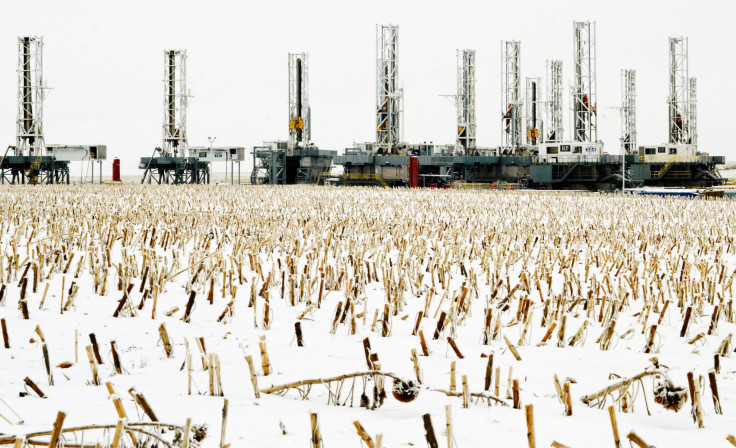Oil Glut 2016: Is A Financial Crisis Lurking In The Hobbled Energy Market?

In any given week, a chorus of doomsayers can be heard from the margins of the financial world proclaiming the onset of the next great crisis. But crises remain relatively rare, and the vast majority of these projections turn out to be wrong.
Some of the keenest market observers have warned more loudly in recent weeks over the potential that the energy market — battered by plummeting oil and gas prices — could contain the seeds of the next crisis.
Jeffrey Rosenberg, chief investment strategist for BlackRock Inc., the world’s largest asset management company, summed up the market’s pessimism in a recent note: “There will be blood,” Rosenberg declared, pointing to “collapsing commodity prices’ risk of spillover into the broader outlook.”
With commodities prices hovering near multidecade lows after years of industry borrowing, analysts worry that the global economy might have plenty more bankruptcies and disruptions to weather in 2016. Investors worry that, like plunging housing prices in 2007, energy sector defaults in the $1.6 trillion junk bond market could spread throughout the wider financial system.
There’s no reason to panic as yet. Markets weathered steep declines in energy and commodities prices amid a wave of selling in January, with crude oil prices dipping below $27 for the first time since 2003. In December, the market for junk bonds — also called high-yield, or speculative-grade, debt — shuddered but stayed intact as two funds shut down suddenly at the onset of rising interest rates.
But there are signs that the worst is yet to come, Nicholas Colas, chief market strategist for Convergex, said. “I don’t think anybody feels that we’re out of the woods yet,” he said. “We have not seen the results of those low [oil] prices quite yet.”
Crude oil has undergone an unprecedented reset since late 2014, with prices falling nearly 70 percent in the past 18 months, sending the energy market into a tizzy of cost cuts and restructuring. Markets don’t expect prices to rebound anytime soon — oil futures for delivery in 12 months cost $41 a barrel, still 60 percent below two-year highs.
More than 40 small companies in the oil patch filed for bankruptcy in 2015, involving some $17 billion in debt, according to law firm Haynes and Boone. Oil majors are feeling the pressure as well, though for most of them sizable cash piles have kept ratings agencies from considering downgrades. On Tuesday, Exxon Mobil Corp. reported a quarterly profit decline of nearly 60 percent. BP posted results that were even worse: a $6.5 billion loss for the final quarter of 2015.

Fears of systemic risk have been driven in part by the recognition that recent declines aren’t just any old asset cycle winding down. Viewed on a longer time frame, the past two years have seen the turbulent end of a decadelong, China-fueled commodities "supercycle," with prices potentially returning to levels characteristic of the 1980s and 1990s.
The rise in prices saw a corresponding rise in the level of debt issued by energy and commodities producers as investors hungry for higher returns flocked to corporate bonds.
The steeply discounted energy costs have shredded the finances of drillers and transporters in the U.S. and globally. Last month the ratings agency Moody’s Investors Service Inc. placed 175 oil, gas and commodities companies on alert for a credit downgrade, imperiling some $540 billion in outstanding debt.
But many American oil companies haven’t yet felt the full sting of low prices. They ordinarily cushion their finances from market fluctuations by purchasing derivatives for years in advance that help lock in favorable prices.

But these hedging vehicles have begun to run out of steam. Today companies involved in oil exploration and production have hedged just 15 percent of their total volumes for 2016, compared with 27 percent in the final quarter of 2015. That means a harder landing if prices remain subdued throughout the year.
“A lot of these companies have been somewhat shielded from the low-price environment,” Paul O’Donnell, principal analyst at IHS Energy Inc., said. “Coming into 2016 it’s going to be a bit more of an impact.”
The highest-risk segment of the market consists of smaller companies, making up just 4 percent of the total oil production, O’Donnell said. But risks could be growing beyond that sliver of the junk debt market.
“Right now what you have is two question marks,” Colas said. “Where do the prices actually bottom, and what are the ripple effects?”
The answer to the second question remains to be seen. Defaults in the oil and gas sector are expected to rise to 11 percent in 2016, from 7 percent in 2015. That relatively localized pain would become an economywide illness only if banks came under duress from mounting defaults of loans to energy and commodities companies.
But that remains a mere possibility, Justin Fuller, a bank analyst at Fitch Ratings Inc., said. “We haven’t seen losses spike up in the bank portfolio as yet,” Fuller said. “Generally it’s more of an earnings story for the banks.”
When the largest American banks reported earnings last month, analysts peppered executives with questions over the lenders’ exposure to the energy sector. Wells Fargo & Co. reported stashing $1.2 billion in reserves to cover potential losses in $17 billion in loans. JPMorgan Chase & Co. set aside $124 million for exposure to the oil and gas space, which chief financial officer Marianne Lake called “the biggest area of stress.”
It’s not just the bank loans, however, that could snap and sting the financial system. Regulators have recently sounded alarms over the increasing share of risky lending carried out by nonbanks, or so-called shadow lenders. In a recent report, the Treasury Department’s Office of Financial Research noted that two-thirds of the highest-risk loans — those with greater-than-average leverage in comparison with company assets — were held by nonbanks.
“We don’t know how deep the hole goes in terms of leverage,” said Mark Friedgan, investor and co-founder of Chicago retail energy supplier Eligo Energy.
Still, despite the buildup of risky assets in shady corners of the financial world, today’s energy market woes don’t line up perfectly with the subprime-mortgage crisis of 2007-08, which was triggered by the collapse in housing prices. U.S. household debt in 2007 totaled $10.5 trillion, more than four times the $2.5 trillion currently locked up in oil and gas debts.
Deutsche Bank chief economist Torsten Slok concluded in a recent note to clients that problems in the high-yield space today "are 15 times smaller than the housing market imbalances we were facing in 2006.” High-yield bonds of all types make up just 2 percent of total debt outstanding now, compared with the 30 percent of debt mortgage-related products made up in 2006.
“There’s a psychology in the market that’s always looking for one thing that’s the fuse that blows everything up,” Colas said, comparing the outbreak of the subprime crisis to today. “People are overly fixated on the analog — but that doesn’t mean it’s wrong.”
© Copyright IBTimes 2024. All rights reserved.






















